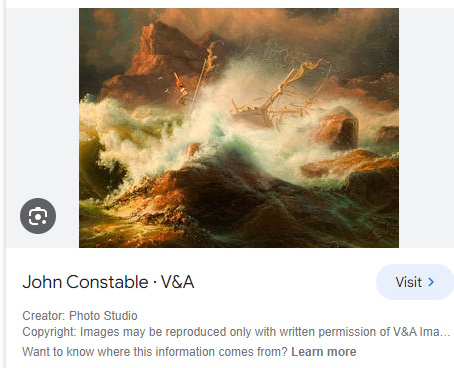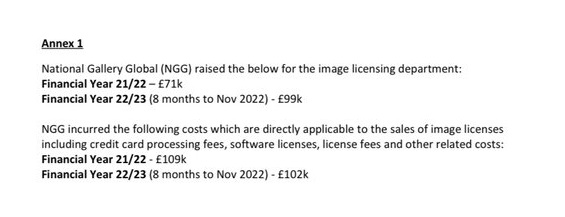Copyright and Image Fees

There's an important development after a recent Court of Appeal ruling. It is Good News for historians and art historians (and art lovers generally). Those of us who've had to pay image fees will know the system relies on museums claiming copyright in their photos - irrespective of whether the art they're photographing is itself in copyright. (In the UK, copyright lasts for 70 years after the death of the artist).
In other words, a painting by John Constable may be long out of copyright, but taking a photo of it creates a new copyright in that photo. By restricting the taking or sharing of other photos, museums force us to use their own photos for publication, and thus charge £££. Copyright is the glue which holds the system together, otherwise, we'd be able to either take a photo from the museum's website, or use a photo someone else has already paid for. The 'copyright licence' we buy prevents us from sharing the image for wider re-use.
In the UK, this copyright claim has for long been contentious. For example, under the 2019 EU Copyright Directive (Article 14), it is not possible to claim copyright in a straightforward reproduction of a work of art which is itself out of copyright (older than 70 years). The relevant bit of Art. 14: "when the term of protection of a work of visual art has expired, any material resulting from an act of reproduction of that work is not subject to copyright or related rights... unless the material resulting from that act of reproduction is original in the sense that it is the author's own intellectual creation."
In other words, take a straightforward photo of the Constable painting = no new copyright in your photo. But pose something in front of it, add an extra cow in Photoshop = new copyright in your photo. For many of us, that EU Directive looked like the end to image fees in the UK - but Brexit happened just before ratification was required in member states. In the UK, museums and image libraries relied on the UK's Copyright, Designs and Patents Act 1988, which appeared to give copyright to your photo of the Constable simply because of the effort you took in taking it. This was called the 'sweat of the brow' concept. In other words, you did not need to demonstrate any creative effort, or add any personal touch, to claim your copyright.
BUT, since 1988, various EU and UK judgements have eroded the 'sweat of the brow' concept. But the situation was still not entirely clear, until now. In an Appeal Court judgement this November (THJ v Sheridan [2023] EWCA Civ 1354). Here's the full judgement. (And here (to which I am indebted) is Prof. Eleonora Rosati.
Para 16 rules that, for copyright to pertain: 'What is required is that the author was able to express their creative abilities in the production of the work by making free and creative choices so as to stamp the work created with their personal touch...' So, taking a straightforward photo does not count, nor does getting the lighting right or other labour of a 'technical' kind.
What does this mean for the image fee system which strangles so much art historical scholarship, prevents the public learning about the art they own, and acts as a tax on knowledge? In the UK, it means it's over.
In fact, because in THJ v Sheridan, the judges said the 'skill and labour' test has not been valid *since 2004*, it suggests that all those 'image licences' which have been sold relying on copyright have been invalid, and (I suspect?) mis-sold. Those of us who've been campaigning against image fees have been arguing (with hard evidence) that the system doesn't raise meaningful revenue for museums (and in many cases, costs them money). But to little avail, as far as museums are concerned. They just carried on charging, insisting they had copyright, which encouraged publishers to insist we kept buying 'licences'.
What do we do now? I suppose museums can carry on restricting the availability of decent photos. That's why Tate's website only lets us see low-res photos (of the art we own). But without the glue of copyright, the system must collapse, because there's nothing to stop images being re-used. So, if you're able to take a tolerably good photo of a historic artwork from online for your publication, do so. Don't let publishers and journals bully you into buying 'licences'. Don't agree to label photos (C) when no copyright exists. And if you're a museum director or trustee, think hard about your museum mis-selling licences for the last two decades.
Raising revenue for museums

I asked the National Gallery [in May 2023] how much money they make from image fees (the licensing cost if you want to publish works in their collection). After initially refusing to answer, they confirmed that actually they lose money.
It turns out that for the National Gallery to employ people to ‘sell’ images [at] all - dealing with licenses, answering enquiries, sending Jpegs, etc - actually outweighs the money generated, So when museums, and their trustees, say ‘sadly we have to raise revenue’ it’s just not true.
In other words, the need for art historians to have to pay excessive fees for images, to further knowledge of *publicly owned* non-copyright art is utterly pointless, a waste of money and time in which everyone - academics, the public, and even museums - loses.


Comments